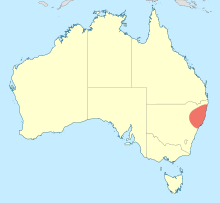Austroargiolestes brookhousei
Austroargiolestes brookhousei is a species of Australian damselfly in the family Megapodagrionidae,[3] commonly known as a Barrington flatwing.[4] It is endemic to northern New South Wales, where it inhabits streams and bogs.[5]
| Barrington flatwing | |
|---|---|
| Scientific classification | |
| Kingdom: | Animalia |
| Phylum: | Arthropoda |
| Class: | Insecta |
| Order: | Odonata |
| Suborder: | Zygoptera |
| Family: | Megapodagrionidae |
| Genus: | Austroargiolestes |
| Species: | A. brookhousei |
| Binomial name | |
| Austroargiolestes brookhousei Theischinger & O'Farrell, 1986[2] | |
 | |
Austroargiolestes brookhousei is a medium-sized to large, black and pale blue damselfly, without pruinescence.[4] Like other members of the family Megapodagrionidae, it rests with its wings outspread.[6]
Etymology
In 1986, Günther Theischinger and Tony O'Farrell named this species brookhousei, an eponym in acknowledgement of the work of Peter Brookhouse who was responsible for collecting specimens for analysis.[2][7]
Gallery
.jpg) Tip of female tail
Tip of female tail.jpg) Tip of male tail
Tip of male tail.jpg) Female wings
Female wings.jpg) Male wings
Male wings
gollark: Anyway, you seem to be treating emotions as... actual physical properties of some sort. They're *not*. They're emergent behavior in people's brains, they're not subject to conservation laws or something any more than the amount of blue on my computer screen is.
gollark: ···
gollark: Like "quantum".
gollark: They are sciency-sounding words which turn up a lot but have somewhat complex definitions.
gollark: I mean, in an extreme edge case, what if there's only one person in the entire universe, they punch a wall, and randomly die for unrelated reasons? How is that going to cause more violence down the line?
See also
References
| Wikimedia Commons has media related to Austroargiolestes brookhousei. |
- Dow, R.A. (2017). "Austroargiolestes brookhousei". IUCN Red List of Threatened Species. 2017: e.T163567A87526828. doi:10.2305/IUCN.UK.2017-1.RLTS.T163567A87526828.en.
- Theischinger, G.; O'Farrell, A.F. (1986). "The genus Austroargiolestes Kennedy (Odonata: Megapodagrionidae)". Odonatologica. 15 (4): 387–428 [409].
- "Species Austroargiolestes brookhousei Theischinger & O'Farrell, 1986". Australian Faunal Directory. Australian Biological Resources Study. 2012. Retrieved 12 April 2017.
- Theischinger, Günther; Hawking, John (2006). The Complete Field Guide to Dragonflies of Australia. Collingwood, Victoria, Australia: CSIRO Publishing. p. 58. ISBN 978 0 64309 073 6.
- Theischinger, Gunther; Endersby, Ian (2009). Identification Guide to the Australian Odonata (PDF). Department of Environment, Climate Change and Water NSW. p. 199. ISBN 978 1 74232 475 3.
- Watson, J.A.L.; Theischinger, G.; Abbey, H.M. (1991). The Australian Dragonflies: A Guide to the Identification, Distributions and Habitats of Australian Odonata. Melbourne: CSIRO. ISBN 0643051368.
- Endersby, I. (2012). "Watson and Theischinger: the etymology of the dragonfly (Insecta: Odonata) names which they published". Journal and Proceedings of the Royal Society of New South Wales. 145 (443 & 444): 34–53 [38]. ISSN 0035-9173 – via Biodiversity Heritage Library.
This article is issued from Wikipedia. The text is licensed under Creative Commons - Attribution - Sharealike. Additional terms may apply for the media files.
